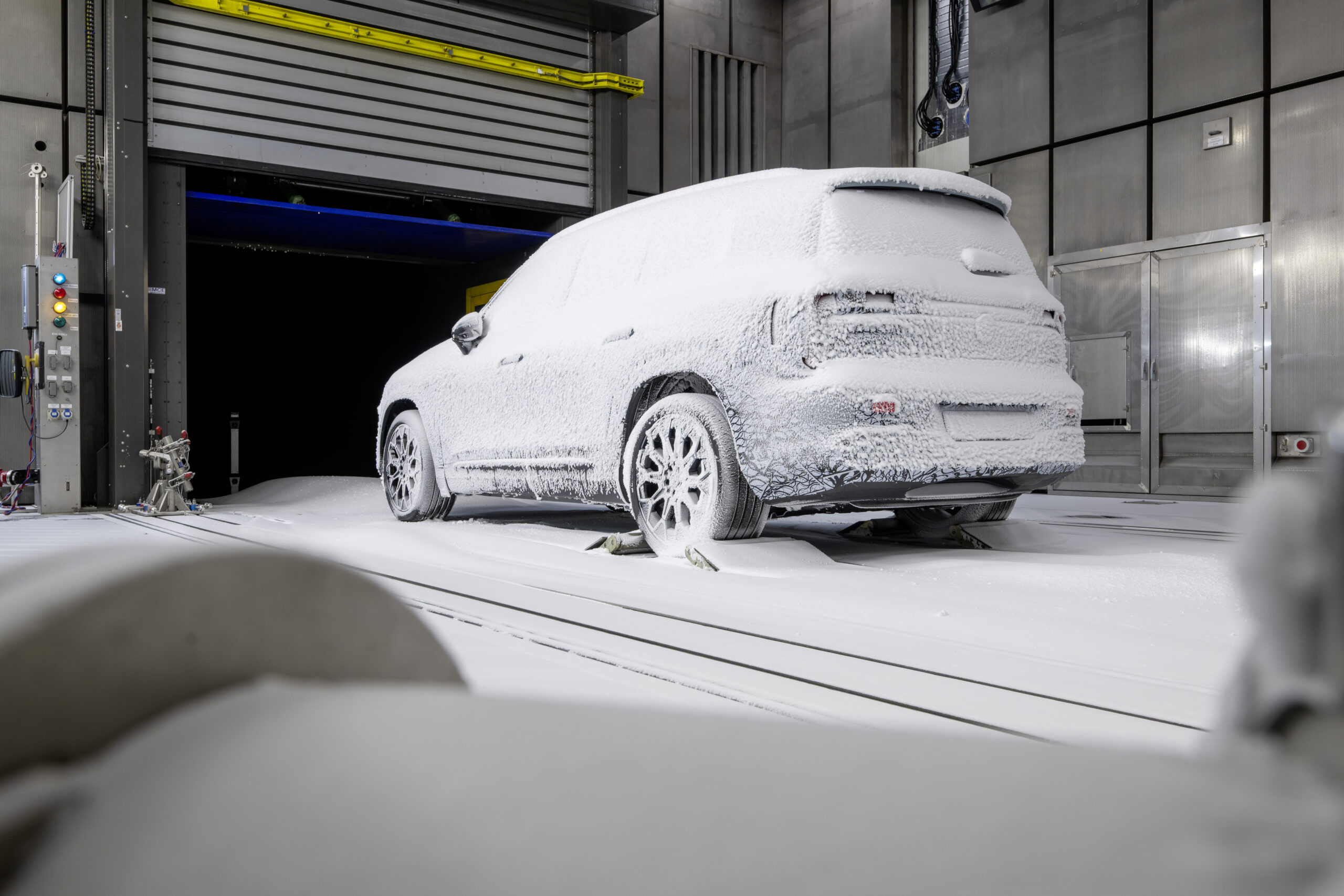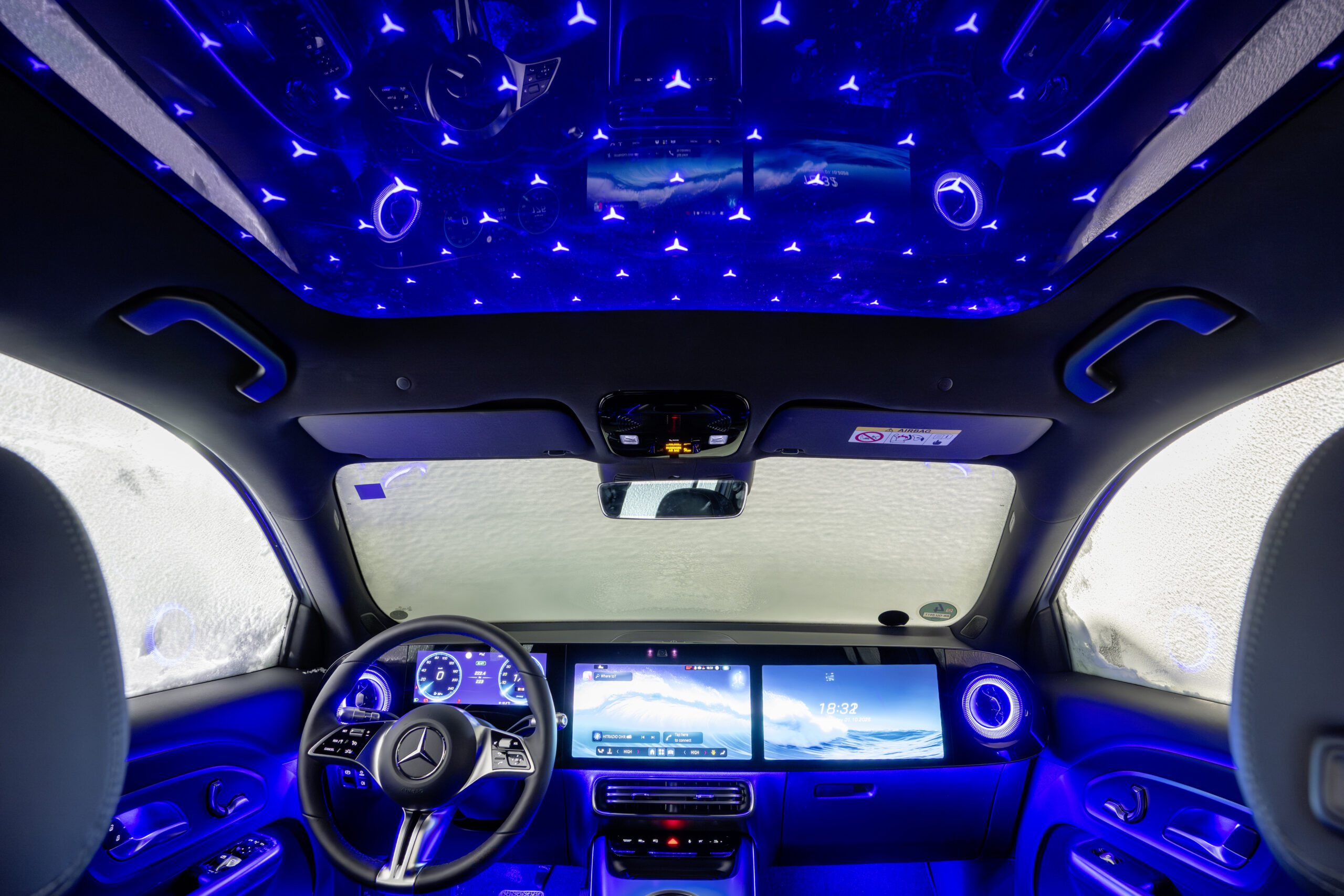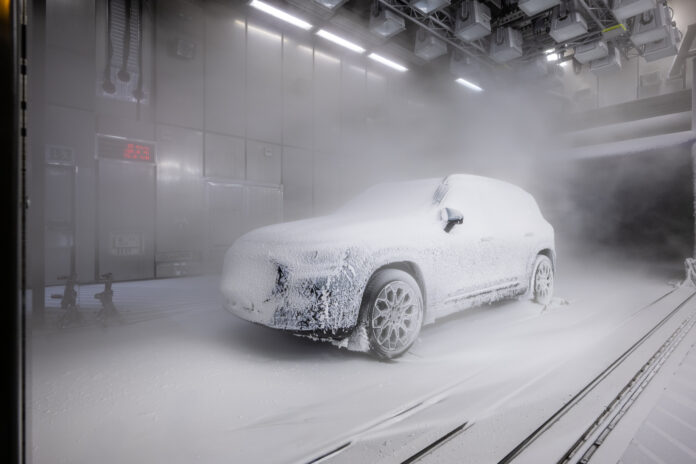Bitter cold and heavy snowfall on the last few kilometers. Windshield wipers and heating are working at full blast to ensure the driver has a clear view and the passengers stay warm. Anyone who skis or snowboards knows these extreme conditions on the way to winter sports. The engineers at Mercedes-Benz also know exactly what challenging winter weather feels like: They are currently conducting intensive cold-weather tests with the new GLB in Sindelfingen before its world premiere on December 8, 2025.
Whether as a spacious five-seater or a flexible seven-seater, the compact SUV is the ideal companion for trips to ski resorts or other winter excursions. Besides superior traction on snowy roads, maximum thermal comfort and reliably clear visibility through quickly defrosted windows are paramount. To ensure the GLB meets the demanding requirements of Mercedes-Benz in these areas and delivers the brand’s signature high quality, it undergoes extensive testing under winter conditions. Two state-of-the-art climate wind tunnels are available for this purpose in Sindelfingen.
Testing at the limit: arctic temperatures and snowstorms in the cold chamber
The temperature range in the so-called cold tunnel generally extends from -40° to +40° Celsius. This covers the vast majority of real-world weather conditions and includes a generous buffer. New snow columns, i.e., compact snow cannons, allow for snowmaking with a wide variety of snow types across a broad temperature range. Combined with the powerful blower of the wind tunnel, this enables the simulation of severe blizzards, in which snowflakes hit the test vehicle at speeds of up to 200 km/h.
Mercedes-Benz’s two climate wind tunnels are packed with sophisticated technology. In each tunnel, a roller test bench simulates the road surface. Powerful electric motors drive four rollers in each tunnel. This allows 4MATIC models to be tested under realistic conditions. The test benches are designed for a total output of up to 780 kW, enabling top speeds of up to 265 km/h. Vehicles can also be refueled and charged in the tunnels.

The all-new Mercedes-Benz GLB, Cold chamber Sindelfingen
The building covers a footprint of 70 by 60 meters. In addition to the two test benches, it houses offices, including a control room. From there, the technicians can regulate temperature, humidity, wind speed, and other parameters. Large, fully insulated windows allow for close observation of every test.
Quality improvement in every season: simulation of the desert sun
And what if the destination isn’t St. Moritz, but St. Tropez, or Lake Garda instead of the Grossglockner? It’s not just snow and ice that pose a challenge for a car and its occupants; heat and solar radiation also present their own set of difficulties. The climate test facilities in Sindelfingen allow for testing under such conditions. Temperatures from -10° to +60° Celsius can be generated in the so-called warm tunnel. In addition, there is a solar simulation system with 32 lamps whose radiation spectrum corresponds to natural sunlight. On an area of 8 by 2.5 meters, the radiation intensity can be varied between 200 and 1,200 watts per square meter. The highest setting is comparable to very intense sunshine, such as that found only in Death Valley in the USA or in a few other remote desert locations.
Another development tool in the hot duct is the so-called “Hot Road”—a simulated road surface. The temperature there can be continuously adjusted between +50° and +70° Celsius, precisely the range a road reaches on a hot summer day. The goal here, too, is to create conditions that are as realistic as possible.
In climate wind tunnels, virtually all weather conditions can be simulated year-round – with very low tolerances. Unlike tests on open roads, the measurements are reproducible at any time. The cold chamber helps Mercedes-Benz to further close the gap between simulation and real-world testing and to continuously improve vehicle quality through even more comprehensive testing.
Swirling snow, icy windows: practical testing
The engineers use the testing facilities of the climate wind tunnels to examine a wide variety of vehicle components and functions. For example, they closely examine the function of the windshield wipers to ensure they work flawlessly in all weather conditions. In the cold tunnel, they check whether snow kicked up by the wind could block the air intakes. In reality, this danger is posed by passing trucks.
In freezing temperatures, the heating system has to demonstrate in the cold tunnel how quickly it can defrost the iced-up windshield. A camera records the entire defrosting process. The new GLB passed these tests with flying colors. At an outside temperature of -15° Celsius, it takes only 15 minutes until the windshield is clear enough to allow driving. And this is achieved solely through the defrost setting of the heating system – entirely without any intervention from the driver, such as switching on the windshield wipers.
Pleasant climate: even shortly after boarding
Freezing in an electric car? Mercedes-Benz drivers only know that from hearsay. The new GLB raises efficiency and climate comfort to a new level. For example, during a 20-minute drive at an outside temperature of -7° Celsius, it heats up the interior twice as fast as its predecessor. This even undercuts the heating time of a conventionally powered model. Compared to its predecessor, the new electric GLB requires only about half the energy. This latter point has a positive effect on the electric range.
The heating process starts automatically as soon as someone gets into the car. Mercedes-Benz’s strategy is to warm the upper body and hands first. This ensures rapid thermal comfort, even without using pre-conditioning. Furthermore, the system is now even more intuitive and convenient to operate and can be adapted to individual needs in a variety of ways. Regardless of whether the occupants are charging, sitting in the vehicle, or even taking a nap, the system seamlessly regulates heating and cooling thanks to its intelligent, predictive operating strategy.
The technical basis for the noticeable increase in comfort is an innovative heat pump adapted from the VISION EQXX technology program. As a so-called multi-source model, it can utilize three energy sources simultaneously: the waste heat from the electric drive and the battery, as well as the ambient air. By using this “free” heat, the heat pump contributes to the GLB’s high efficiency. It requires approximately one-third of the electrical energy that a comparable auxiliary heater would need for the same output.

The new Mercedes-Benz GLB, Interior
Welcome home: Comfort redefined in the compact SUV segment
The previous sculptural design has been replaced by a purist concept focusing on individual iconic high-tech elements. The design is reduced to the essentials, conveying a highly modern and elegant ambiance. A highlight of the interior is the optional, floating MBUX Superscreen, which stretches across the entire width of the vehicle.
The round air vents at the ends of the MBUX Superscreen have a sporty and futuristic look. Rings in Silver Shadow appear to float in front of a funnel-shaped form. The center vent replaces the usual louvers with a flat, state-of-the-art body. Another highlight is the doors, whose concave shape recedes into the background. The generously sized, floating door panels integrate an open storage compartment. The classic tubular door handle appears streamlined, yet powerful and sporty.
The floating center console completes the design. It flows elegantly beneath the MBUX Superscreen and offers a large, three-dimensional trim surface available in various luxurious finishes. Mercedes-Benz integrates a smartphone storage compartment with optional wireless charging and cupholders into this trim element in an aesthetically pleasing design.
The new steering wheel is even more ergonomically designed and more intuitive to use. Responding to numerous customer requests, Mercedes-Benz has reintroduced the operating concept with rocker switches for the speed limiter and DISTRONIC, as well as a rotary dial for volume control.
More space and flexibility in the interior
The new GLB is available as a five- or seven-seater. It effortlessly adapts to a wide range of needs and offers plenty of space for family, friends, and spontaneous plans. Compared to its predecessor, the GLB offers noticeably more headroom in the first two rows of seats. This is due to the SUV’s roofline and the standard panoramic sunroof. Rear passengers will also appreciate the increased legroom. Seating comfort in the second row has been significantly improved, including a longer thigh support.
A longitudinally adjustable rear bench seat is available as an option for the five-seater and standard on the seven-seater. This feature allows the backrests of the second row to be adjusted to several angles and the entire row of seats to be moved lengthwise. This allows either passenger comfort to be maximized or the luggage compartment volume to be increased.
The optional third row of seats is easier to access than in the previous model. This is partly due to the significantly longer adjustment range of the Easy-Entry function. If seats six and seven are not needed, the third row can be folded flat into the load floor.
The large panoramic roof sets a new standard in its segment. It creates an exceptionally spacious and open feeling. To protect against solar radiation, it consists of heat-insulating laminated safety glass with an infrared-reflecting coating and a low-emissivity (LowE) coating on the inside. This reduces the heating of the vehicle interior in summer. In winter, the LowE coating reduces heat loss by reflecting the interior heat back into the cabin. At 200 nanometers thick, it is thinner than a human hair, which has a diameter of approximately 50,000 nanometers.
Optionally, the glass’s transparency can be adjusted segment by segment in 10 to 20 milliseconds. Passengers can choose between transparent for an unobstructed view upwards and opal (milky) for greater privacy. The opal (milky) setting not only protects against prying eyes but also provides improved glare protection in direct sunlight. This function is controlled via a menu in the vehicle settings on the central display.
The ultimate feature: The large panoramic roof is optionally illuminated. It’s integrated with the ambient lighting, creating a luminous starry sky. The stars are illuminated in the individually selected color of the ambient lighting. The light is supplied from the front via LED modules.

The all-new Mercedes-Benz GLB, Cold chamber Sindelfingen
The Mercedes-Benz Operating System (MB.OS), a true mastermind, transforms the GLB into an intelligent companion that thinks, learns, and evolves alongside its driver. Highlights of the new MBUX generation include the new operating concept with redesigned welcome animations and the enhanced Zero Layer, a comprehensive app selection, the MBUX Virtual Assistant with various emotionally responsive avatars and generative artificial intelligence, navigation with Google Maps, and MBUX Surround Navigation.
Furthermore, MB.OS enables advanced driver assistance systems. The new GLB features a comprehensive suite of driver assistance systems, including the DISTRONIC adaptive cruise control, which is standard equipment in Europe. The hardware comprises eight cameras, five radar sensors, twelve ultrasonic sensors, and a water-cooled high-performance computer with ample power reserves for future functions and regular over-the-air updates. Mercedes-Benz bundles all these assistance systems under the name MB.DRIVE. Many are available as Digital Extras [1] at market launch or can be updated later.
[1] To use the Digital Extras, customers must create a Mercedes me ID and agree to the Terms of Use for Digital Extras and the Mercedes me ID Terms of Use in their currently valid versions. The respective vehicle must also be linked to the user account. After the limited term expires, the Digital Extras can be extended for a fee, provided they are still offered for the corresponding vehicle.


